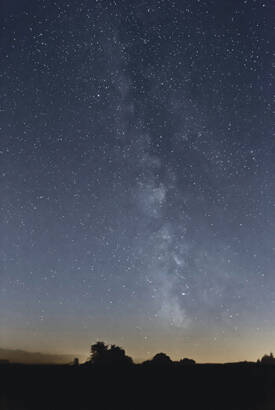Many Christians who learn about modern cosmology from popular sources wonder how new discoveries about the universe mesh with their faith. A host of questions may arise: What is the nature of the universe as a whole, and how did it come to be as it is now? Did it have a beginning in time, or has it undergone cycles of birth and destruction? Is the cosmos infinite in its extent? Are the laws of nature the same everywhere? Cosmology is a branch of astronomy that seeks to answer questions like these. It is the science of the universe on the largest scales of space and time. These days, it is progressing by leaps and bounds.
In my experience, most popular curiosity about cosmology boils down to two issues: beginning and bigness. Does current science support the Christian doctrine that in the beginning God created the universe from nothing? And now that we know that the universe is so much bigger than the biblical authors believed, does that change how we ought to conceive of its creator and God’s relationship with us?
These questions, though profound, are not new. Modern cosmology might keep these questions relevant and give them freshness, but it does not significantly alter the theological terrain. It is not my intention, however, to deflate interest in integrating scientific discovery with religious faith. Once these questions are put in proper perspective, the real value of today’s cosmology for Christian faith can shine through.
A Tour of the Universe
We live in an exciting era for cosmology. Although ingenious and profound cosmological theories have been proposed throughout history and across cultures, only relatively recently have astronomers been able to start figuring out which theories are actually right—and to discover that there are new puzzles to be solved.
The medium of astronomy is light. The spectacular advances in cosmology over the past century are thanks in large part to the increasing size of telescopes and the increasingly sensitive cameras that can capture more and more of the precious light coming from the heavens.
With the help of such improvements, scientists established for sure, less than 100 years ago, that our own Milky Way, itself made up of a few hundred million stars, is but one galaxy among a multitude. Today we know that we are part of a “local group” of about 50 galaxies in a volume roughly 10 million light years across. (A light-year is the distance light travels in one year—about six trillion miles. To get a sense of scale, the sun is about eight light-minutes from the earth, the next nearest star is four light-years away, and the Milky Way is about a hundred thousand light-years in diameter.) Our local group is not alone. Everywhere we look, we see other groups of galaxies, some large, some small, numbering in the billions. The universe is truly gigantic.
Since light travels at a finite speed, looking farther in distance means peering further back in time. This has allowed us not only to study the universe as it looks today, but to understand its history. For about 50 years now, it has been clear that the universe is expanding. The universe began as a tiny seed 14 billion years ago and has been growing ever since. With powerful telescopes, we can detect the faint glow of microwave light that the infant universe emitted just after its birth, when it was a thousand times smaller than today and before stars and galaxies had even been formed.
What is expanding is space itself. Imagine galaxies as dots painted on a giant rubber sheet. It is not that the dots themselves are moving, but that the rubber sheet—space—is being stretched, pulling them along with it. The universe is not expanding into anything: the very space in which stars, galaxies, planets and everything else exist is stretching, causing the distances between all its contents to grow.
The fact that we have been able to determine this much is what makes cosmology today exciting. What makes things equally exciting is that there are new questions to be answered. Although it is clear that the universe as we know it began in some kind of Big Bang, the physics of the very few instants is not understood. It is not known what might have triggered the universe’s expansion, nor what things were like before that time.
There is also this puzzle: the ordinary matter that forms planets, stars and galaxies—hydrogen, helium and the other atomic elements we learn about in chemistry class—cannot account for all the gravitational strength we observe in the heavens. The rotation and interaction of galaxies, as well as the rate of expansion of the universe, all indicate that there is a large quantity of dark matter contributing to gravity’s pull. We have very little idea what this dark matter is made of. Even more surprising was the discovery in the late 1990s that the universe is not only expanding; it is expanding more and more rapidly. Since gravity would tend to slow the expansion, there must be some mysterious force pushing everything apart. We call it dark energy. When everything is added up, the universe is made up of about 72 percent dark energy, 23 percent dark matter and just 5 percent atoms, or “regular” matter. Although we can describe its evolution, we still do not know what 95 percent of the universe is actually made of.
New Science, Old Questions
This brief summary does not do justice to the scope and richness of modern cosmology and astrophysics, but it should lead to an understanding of how to approach the religious questions that arise about the universe’s origin and size.
Through much of Western history, it was thought that the motions of the heavens were regular and unchanging. The Christian notion that the cosmos had a beginning in time had to be accepted as an article of faith. With the advent of the Big Bang theory, it might seem that science corroborates revelation, but it is not that simple. The first instants of the Big Bang are not understood. Perhaps it really was the temporal beginning of the universe, but it is also possible that the universe existed in some prior state before the Big Bang. Some leading theorists have even developed cyclical models involving higher dimensions, where the Big Bang repeats itself over and over again.
Today’s science does not say whether the universe was created from nothing. It is arguably not even a question for physical science. St. Thomas Aquinas taught that the temporal beginning of creation is known only by faith, and cautioned anyone trying to prove it using either philosophy or science. His reason is especially pertinent today: “lest anyone, presuming to demonstrate what is of faith, should bring forward reasons that are not cogent, so as to give occasion to unbelievers to laugh, thinking that on such grounds we believe things that are of faith.”
There is similar continuity regarding the universe’s bigness. Although modern cosmology allows us to speak in more quantitative terms about the size of the cosmos, people have always known that it is big. Even in the Middle Ages, when people believed that the earth was the center of the universe, it was taught that the earth is so small compared to the rest of creation that it should be treated like a mathematical point. One medieval author whimsically reported that if one traveled vertically at a rate of 40 miles per day, it would take more than 8,000 years to reach the firmament of stars—a distance of more than 100 million miles!
To the human imagination, big is big. Whether the distance to the nearest stars is 100 million miles or, as we know now, 25 trillion miles, the size is beyond the range of human imagination. This explains why people throughout history have reacted in a similar way before the scale of the cosmos. The author of Psalm 8, writing thousands of years ago, did not need to have exact numerical measurements to exclaim in wonder to the Lord:
When I consider your heavens, the work of your fingers, the moon and the stars, which you have set in place, what is mankind that you are mindful of them, human beings that you care for them?
The rest of the psalm implicitly answers the perennial question it asks. Physical bigness makes no difference to God. Perhaps it is the opposite. After all, David defeated Goliath, and Jesus decided to dine with Zacchaeus. The humility with which God took flesh, who “made himself nothing...being made in human likeness” (Phil 2:7), strikes home when we consider how small that really was. It obliterates any notion that God’s love depends on size.
Contemplatives Beneath the Heavens
If modern cosmology does not provide new theological insight into questions of origins or bigness, one can discover anew the lessons of old.
New cosmological discoveries remind us of the wonder we ought to have before creation. Unlike our ancestors, who saw the stars above them every night, many city-dwellers, surrounded by artificial lights 24 hours a day, have been cut off from the heavens. Half the world’s population is now urbanized, and the fraction is growing. Ironically, despite our great scientific knowledge, we may be regressing in our aesthetic experience of the night sky, for we rarely see it. A connection with the heavens was important to the psalmist and to other biblical authors. We could also look to St. Ignatius Loyola, who during one period derived his greatest spiritual consolation from contemplating the stars.
We can today reclaim an aesthetic appreciation for the cosmos, but we have to be more intentional than our forebears, who needed only to wander outside after dark. The beautiful images and fascinating discoveries that come from modern observatories are an excellent aid. As Christians, we ought to welcome astronomical research. Not only will it dispel the tiresome but tenacious myth that Christianity is hostile to science; more important, it will help us be better contemplatives.
This attitude can also put theological questions like that about the temporal beginning of the universe in proper perspective. Instead of being disappointed that physical science is incapable of clarifying religious or metaphysical questions, we ought to be grateful for the authentic complementarity between religion and science. Physical cosmology cannot tell us whether or not the universe was created ex nihilo, but it does something better. It tells us things that divine revelation never has: how long ago the Big Bang occurred; how the first stars came to coalesce out of the expanding, primordial gas; how galaxies have grown, interacted and merged. It is also revealing wonders that we never expected, like the fact that ordinary matter makes up only a small fraction of the material in the universe, or that there is an energy field stronger than gravity accelerating the expansion of space.
“The heavens declare the glory of God,” Psalm 19 begins. As science continues to uncover the beauties of the heavens, we hear that voice more clearly. We understand more of the work that the Divine Artist has wrought and continues to accomplish. And in doing so, we give God greater glory.









“WONDERS OF THE UNIVERSE” is wonderful! The universe, or more accurately the “multiverse” swirling in and about us, for we are part of it, had a beginning but seems to ever be in a state of “new beginnings” – God loves “new beginnings” creation still unfolding in unfathomable enormity. It’s vast fling indicative of infinity’s link, or is it “blink,” shared by all creation, a purposeful never to be completed link/ blink, keeping the eyes of the Creator wide open and in full control of developmental principles some call “evolution.” All creation is clearly marked by the fingerprint of infinity, which gives credence to the well-known adage, “Only a fool says … there is no God!”
The multiverse as does a seed, appears self-destructive, which like a seed unless “it falls into the ground (into a black hole) and dies remains only a seed.” So, indescribable rootings, impregnations, unifications happen in collisions, the sound like whimpers so vast the “room” coming from galactic organized chaos, cradling stardust ever ancient, ever new! And on and on it goes, new discoveries both confirming and baffling human wisdom, toppling wisdom of men by the apparent foolishness of God teaching all as Scripture says, “The foolishness of God is wiser than the wisdom of men!” And so it shall ever be. We’ll never fully get it!
But where did the Production Management of the multiverse commence? In a “Void!” What is a “Void?” A “Void” is “emptiness” and that’s where Scripture says that the production, or creation of materiality began.'"The Spirit moved over the void." When I worked as Production Manager for an Industrial Feeding Company responsible for the preparation and consummation of thousands of meals daily operating annually on a million dollar budget, I always began with “something” and had Quantity and Quality Prediction Records to rely on. But when the Divine Production Manager began his work, he had nothing to rely on, no product, no “how to” records, nothing. So, that’s exactly what he used, NOTHING! Well, not really, for as God he was “Mr. Everything!”
However, while the Creator did produced everything “out of nothing” he did work within “something,” just as in Food Production where everything created is produced on, over, and within a variety of containers. The Void of Emptiness was the “Divine receptacle” into which everything was stirred and is still being stirred! So, as it was then, is now and will ever be, the Divine Production Manager depended then and still depends on “outside” helpers to get the job done, “receptacles” so to speak, in which to “stir the stew.” In relation to creation Holy Scripture calls that “pot” the “Void!” In relation to us, it’s a matter of Science enlightened by Faith and Faith enlivened by Science – Two Spoons, stirring the same pot! How delectable!
I enjoyed reading this article but don’t understand how the author seems satisfied with "how the first stars came to coalesce out of the expanding, primordial gas." If the universe did start from a single dimensionless point, what forces acted on the freshly created matter to destroy its symmetry and cause it to evolve into the “lumpy” universe we see today? Rational explanations elude me but deepen my faith.